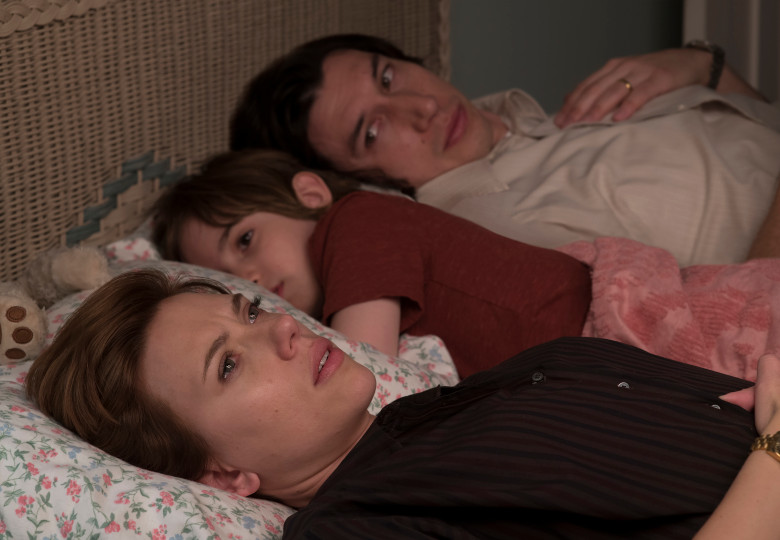July 30, 2019

The following is a press release from Film at Lincoln Center:
Film at Lincoln Center announces Noah Baumbach’s “Marriage Story” as Centerpiece of the 57th New York Film Festival (September 27 – October 13), making its New York premiere at Alice Tully Hall on Friday, October 4, 2019. “Marriage Story” will be released in select theaters and on Netflix later this year.
Noah Baumbach’s new film is about the rapid tangling and gradual untangling of impetuosity, resentment, and abiding love between a married couple negotiating their divorce and the custody of their son. Adam Driver is Charlie, a 100-percent New York experimental theater director; Scarlett Johansson is Nicole, his principal actress and soon-to-be L.A.-based ex-wife. Their “amicable” breakup devolves, one painful rash response and hostile counter-response at a time, into a legal battlefield, led on Nicole’s side by Laura Dern and on Charlie’s side by “nice” Alan Alda and “not-so-nice” Ray Liotta. What is so remarkable about “Marriage Story” is its frank understanding of the emotional fluctuations between Charlie and Nicole: they are both short-sighted, both occasionally petty, both vindictive, and both loving. The film is as harrowing as it is hilarious as it is deeply moving. With Merritt Wever and Julie Hagerty as Nicole’s sister and mom, and Azhy Robertson as their beloved son, Henry.
“What amazed me about ‘Marriage Story’ is the way that Noah keeps the many conflicting emotions between his characters flowing into and around and under and over each other, so beautifully that the film achieves the condition of music,” said New York Film Festival Director and Selection Committee Chair Kent Jones. “In fact, it actually flowers into song in two of the film’s loveliest and most surprising moments. ‘Marriage Story’ is a heartbreaker, it’s very funny, and it has an emotional complexity that’s worthy of Bergman.”
“I grew up coming to the New York Film Festival with my parents. And it’s where my first film ‘Kicking and Screaming’ premiered 24 years ago,” said Baumbach. “I couldn’t be more thrilled and proud that ‘Marriage Story’ has been selected as Centerpiece of the NYFF. The 14-year-old me’s mind is blown; the 49-year-old me’s mind is also blown.”
Presented by Film at Lincoln Center, the 17-day New York Film Festival highlights the best in world cinema, featuring works from celebrated filmmakers as well as fresh new talent. The selection committee, chaired by Jones, also includes Dennis Lim, FLC Director of Programming, and Florence Almozini, FLC Associate Director of Programming.
Tickets for the 57th New York Film Festival will go on sale to the general public on September 8. Festival and VIP passes are on sale now and offer one of the earliest opportunities to purchase tickets and secure seats at some of the festival’s biggest events, including Centerpiece. Support for the Centerpiece of the New York Film Festival benefits Film at Lincoln Center in its non-profit mission to support the art and craft of cinema.
FILM AT LINCOLN CENTER
Film at Lincoln Center is dedicated to supporting the art and elevating the craft of cinema and enriching film culture.
Film at Lincoln Center fulfills its mission through the programming of festivals, series, retrospectives, and new releases; the publication of Film Comment; the presentation of podcasts, talks, and special events; the creation and implementation of Artist Initiatives; and our Film in Education curriculum and screenings. Since its founding in 1969, this nonprofit organization has brought the celebration of American and international film to the world-renowned arts complex Lincoln Center, making the discussion and appreciation of cinema accessible to a broad audience, and ensuring that it remains an essential art form for years to come.
Support for the New York Film Festival is generously provided by Official Partners HBO, Campari, and The New York Times, Benefactor Partners Netflix, illy caffè, and Dolby, Supporting Partner Warby Parker, and Contributing Partners Hudson New York-an SBE Hotel and IMDbPro. JCDecaux, Variety, Deadline Hollywood, WNET New York Public Media and Shutterstock serve as Media Sponsors. American Airlines is the Official Airline of Film at Lincoln Center.
Film at Lincoln Center receives generous, year-round support from the National Endowment for the Arts and the New York State Council on the Arts with the support of Governor Andrew M. Cuomo and the New York State Legislature. For more information, visit www.filmlinc.org and follow @filmlinc on Twitter and Instagram.
